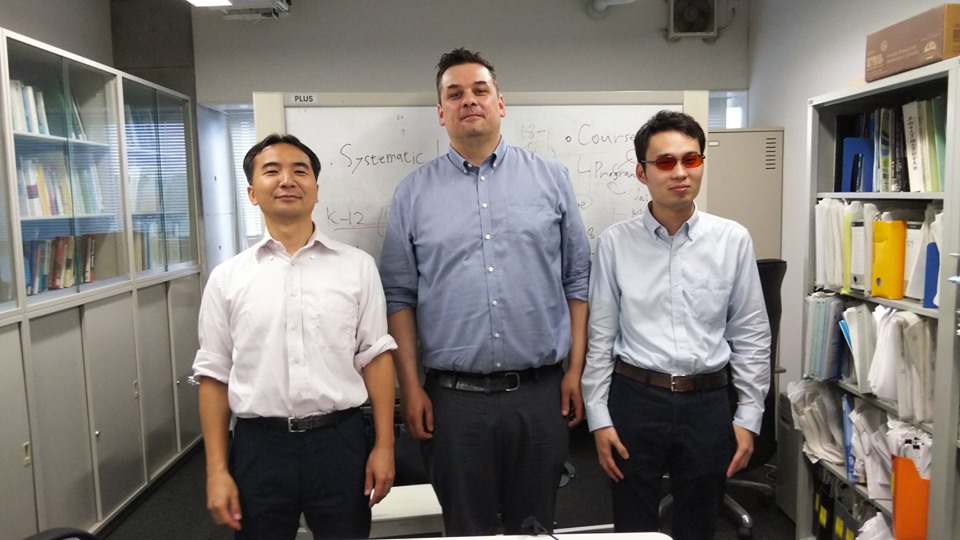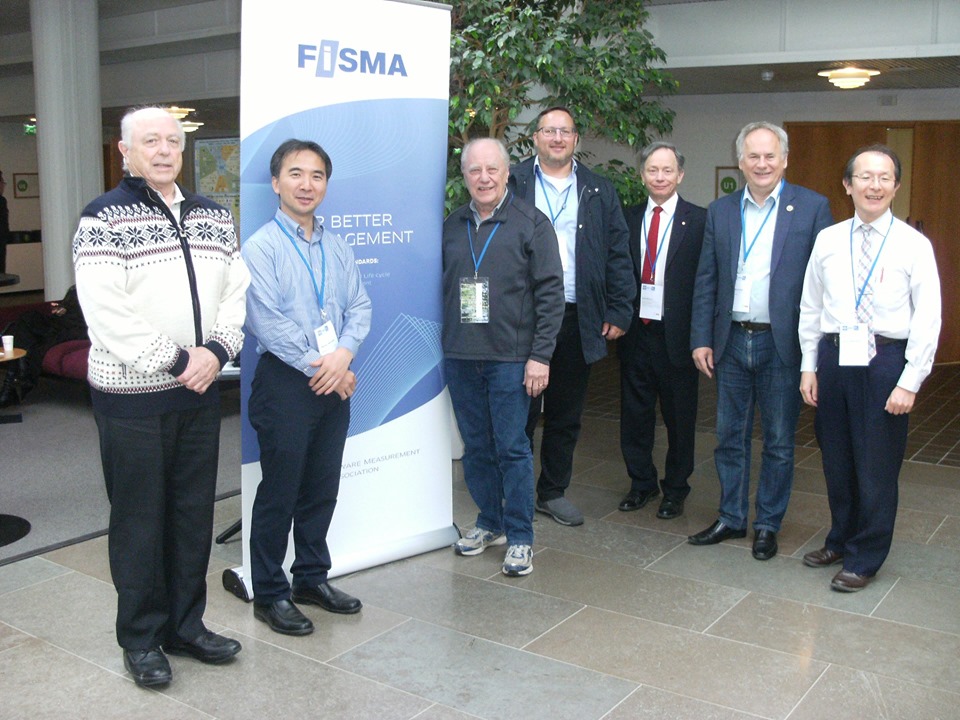As of June 5th 2019, Stéphane Duguay from Université du Québec à Rimouski (UQAR) is currently staying at Tokyo, Waseda University to investigate various Programming teaching courses and conduct joint research with our team. Welcome!
Effects of software modifications and development after an organizational change on software metrics value, accepted for IEICE Trans. Info. & Sys. (SCIE indexed)
Ryo Ishizuka, Naohiko Tsuda, Hironori Washizaki, Yoshiaki Fukazawa, Shunsuke Sugimura and Yuichiro Yauda, “Effects of software modifications and development after an organizational change on software metrics value,” IEICE Transactions on Information and Systems, Letter, pp.1-3, 2019. (SCIE indexed)
Deterioration of software quality developed by multiple organizations has become a serious problem. To predict software degradation after an organizational change, this paper investigates the influence of quality deterioration on software metrics by analyzing three software projects. To detect factors indicating a low evolvability, we focus on the relationships between the change in software metric values and refactoring tendencies. Refactoring after an organization change impacts the quality.
What are good discussions within bug report comments for shortening bug fixing time? accepted for QRS 2019 as short paper (CORE Rank B)
Yuki Noyori, Hironori Washizaki, Yoshiaki Fukazawa, Keishi Ooshima, Hideyuki Kanuka, Shuhei Nojiri and Ryosuke Tsuchiya, “What are good discussions within bug report comments for shortening bug fixing time?” The 19th IEEE International Conference on. Software Quality, Reliability & Security, Short Paper, July 22 – 26, 2019. Sofia, Bulgaria. (CORE Rank B)
Prof. Washizaki organized ISO/IEC/JTC1 SC7/WG20 had a very productive Plenary Meeting at Espoo, Finland, May 20-24 2019
ISO/IEC/JTC1 SC7/WG20 (Convenor: Prof. Washizaki) had a very productive Plenary Meeting 219 at Espoo, Finland. We are standardizing BOK, Skill, Competency and Certification Schemes in Systems and Software Engineering. Next interim will be from Nov 11 to 13 (or 15) at Delft, Netherlands. See you all!
情報通信技術委員会(TTC)2019年度「IoT/BD/AI時代に向けたデジュール及びフォーラム標準に関する標準化動向調査」に、IoTおよび機械学習を中心とした超スマート社会基盤における広義の信頼性技術の標準・動向調査(代表: 鷲崎、分担: 齋藤)採択
情報通信技術委員会(TTC)2019年度「IoT/BD/AI時代に向けたデジュール及びフォーラム標準に関する標準化動向調査」に、IoTおよび機械学習を中心とした超スマート社会基盤における広義の信頼性技術の標準・動向調査(代表: 鷲崎、分担: 齋藤)採択。IEEE会議を調査し、まとめを公開いたします。
A case study of applying GQM+Strategies with SysML for IoT application system development, accepted as regular paper for AAI/EAIS 2019
Toshinori Takai, Katsutoshi Shintani, Hideki Andoh and Hironori Washizaki, “A case study of applying GQM+Strategies with SysML for IoT application system development,” 4th International Conference on Enterprise Architecture and Information Systems (EAIS 2019) as a part of 8th International Congress on Advanced Applied Informatics (IIAI AAI 2019), regular paper, July 7–12, 2019, Toyama, Japan
Implementation and evaluation of GQM+Strategies for Management By Objectives (MBO), accepted as short paper for AAI/EAIS 2019
Norifumi Nomura, Katsutoshi Shintani and Hironori Washizaki, Katsutoshi Shintani and Natsuki Mimura, “Implementation and evaluation of GQM+Strategies for Management By Objectives (MBO),” 4th International Conference on Enterprise Architecture and Information Systems (EAIS 2019) as a part of 8th International Congress on Advanced Applied Informatics (IIAI AAI 2019), short paper, July 7–12, 2019, Toyama, Japan
Linking business strategies and system demands using GQM+Strategies and Systems Modeling Language, accepted as regular paper for AAI/EAIS 2019
Shuji Okuda, Hironori Washizaki, Katsutoshi Shintani and Natsuki Mimura, “Linking business strategies and system demands using GQM+Strategies and Systems Modeling Language,” 4th International Conference on Enterprise Architecture and Information Systems (EAIS 2019) as a part of 8th International Congress on Advanced Applied Informatics (IIAI AAI 2019), regular paper, July 7–12, 2019, Toyama, Japan
Many businesses align their business goals and IT strategies to strengthen the validity of business processes. However, the relationships between goals and strategies are often vague. Thus, the level of success derived from their interrelationships may be ambiguous. By coupling GQM+Strategies and SysML, we propose a framework to systematically associate business requirements and system functions. Moreover, we define a profile in Unified Modeling Language (UML), which allows a model to be created by coupling GQM+Strategies and a SysML-requirement diagram.
Generating Linear Temporal Logics based on Property Specification Templates, accepted for IEEE/ACIS SNPD 2019 (CORE Rank C)
Weibin Luo, Hironori Washizaki and Yoshiaki Fukazawa, “Generating Linear Temporal Logics based on Property Specification Templates,” 20th IEEE/ACIS International Conference on Software Engineering, Artificial Intelligence, Networking and Parallel/Distributed Computing (SNPD 2019), July 8-10, 2019, Toyama, Japan (CORE Rank C)
Temporal logics are widely used in software verification such as model checking. However, creating temporal logics such as linear temporal logics (LTLs) based on property specifications written in a natural language is difficult due to practitioners’ unfamiliarity with property specifications and notations of temporal logics. Although property specification patterns have been introduced to help write correct temporal logics, creating temporal logics using property specification patterns requires an understanding of the pattern system. Since some patterns are difficult to understand, especially for beginners, and the final temporal logics are usually complicated, creating temporal logics using pattern systems is time consuming and error-prone. Here, we introduce a method to create LTLs based on property specification patterns. We experimentally compare the required time and accuracy of our approach to those using property specification patterns. Our approach can improve the creation of LTLs in terms of speed and accuracy. Although our experiment is implemented in Japanese, the results should be applicable to other languages such as English. We also provide a visualization scheme so that practitioners can understand the generated LTLs and confirm that they are correct.
Metrics to Predict Future Modifications and Defects Based on Software Requirements Specifications (SRSs), accepted for IEIE Transactions on Smart Processing and Computing (Scopus indexed)
Taketo Tsunoda, Hironori Washizaki, Yosiaki Fukazawa, Sakae Inoue, Yoshiiku Hanai, Masanobu Kanazawa, “Metrics to Predict Future Modifications and Defects Based on Software Requirements Specifications (SRSs),” IEIE Transactions on Smart Processing and Computing, Vol. 8, pp. 1-9, 2019. (invited from TENCON 2018)(Scopus indexed)
In software development, the quality of the upstream process greatly affects the quality of the downstream process. However, few have applied metrics to estimate quality, controlled the quality quantitatively, or verified the relationship between specifications and software quality. One reason is that specifications are described in a natural language, making it difficult to quantitatively evaluate software metrics such as complexity. Although high-quality software requirement specifications (SRSs) lead to successful implementation, neither a simple quantitative evaluation nor an effective indicator to predict modification-prone SRSs exist. Herein the effectiveness of two specification metrics (number of pages and number of previous modifications) to predict future modifications of SRSs and software defects are evaluated. We confirmed that specification quality measured by the specification metrics and software quality measured by the number of defects are related. We also revealed that future modifications are correlated with the size of SRSs.

